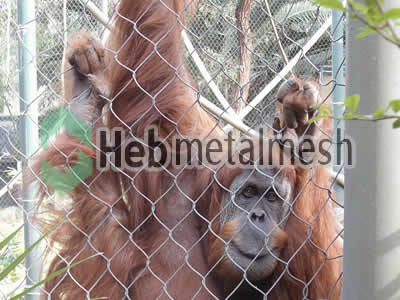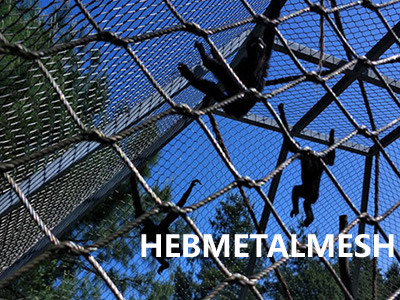As an animal lover, I have always been fascinated by the idea of visiting a zoo. The thought of seeing exotic animals up close and personal is truly exciting. However, as I’ve grown older, I’ve come to realize that zoo mesh is not just for our entertainment, but they play a crucial role in the welfare and wellbeing of animals. In this article, I will discuss the importance of zoo enclosures, the benefits of stimulating zoo cages for animal health, examples of successful zoo exhibits, the role of zookeepers in creating and maintaining animal exhibits, common misconceptions about zoo enclosures, criticisms and controversies surrounding zoo cages, innovations in zoo cages design, and the future of zoo exhibit and animal welfare.

Introduction to Zoo Enclosures
Zoo enclosures are habitats designed to meet the physical and behavioral needs of animals. These habitats are designed to replicate the natural environment of the animals so that they can live and thrive in captivity. Zoo enclosures come in a variety of shapes and sizes, depending on the species of animals that they house. They are designed to provide shelter, food, water, and space for the animals to roam and play.
The Importance of Animal Enclosures for Animal Welfare
Zoo enclosures are crucial for the welfare of animals. In the wild, animals have access to vast territories, plenty of food, and a variety of physical and social stimuli. However, when animals are kept in captivity, they are forced to live in much smaller spaces, with limited access to natural resources. This can lead to stress, boredom, and even physical and mental health problems.
Zoo enclosures play a crucial role in addressing these issues. They are designed to provide animals with a safe and comfortable environment that meets their physical and behavioral needs. In addition, they provide opportunities for animals to engage in natural behaviors, such as hunting, foraging, and socializing. This helps to reduce stress and boredom, and promote physical and mental health.
The Benefits of Stimulating Zoo Enclosures for Animal Health
Stimulating zoo enclosures have numerous benefits for animal health. For example, they can help to reduce stress and boredom, which can lead to a variety of physical and mental health problems. In addition, stimulating zoo enclosures can help to promote physical fitness, mental stimulation, and socialization.
One example of a stimulating zoo enclosure is the polar bear exhibit at the Toronto Zoo. The exhibit features a large pool, rocks, and other environmental features that mimic the natural environment of polar bears. The enclosure also features a variety of toys and puzzles for the bears to play with, which helps to keep them mentally stimulated and engaged.
Examples of Successful Zoo Enclosures
There are many successful zoo enclosures around the world that have been designed to meet the needs of animals. One example is the African savanna exhibit at the San Diego Zoo. The exhibit features a large open space with grasslands, trees, and watering holes. It is home to a variety of African animals, including giraffes, zebras, and gazelles. The exhibit provides the animals with a natural environment that meets their physical and behavioral needs.

Another successful zoo enclosure is the Great Ape House at the Smithsonian National Zoo. The enclosure features a large indoor space with climbing structures, ropes, and other environmental features that mimic the natural environment of great apes. The enclosure also features a variety of toys and puzzles for the apes to play with, which helps to keep them mentally stimulated and engaged.
The Role of Zookeepers in Creating and Maintaining Animal Enclosures
Zookeepers play a crucial role in creating and maintaining animal enclosures. They are responsible for ensuring that the enclosures meet the physical and behavioral needs of the animals, and that they are kept clean and safe. They also provide food, water, and medical care for the animals.
In addition, zookeepers play a crucial role in providing environmental enrichment for the animals. This includes providing toys, puzzles, and other forms of mental stimulation to keep the animals engaged and happy. They also provide opportunities for the animals to engage in natural behaviors, such as hunting, foraging, and socializing.
Common Misconceptions About Zoo Enclosures
There are many misconceptions about zoo enclosures. One of the most common misconceptions is that zoo enclosures are too small for animals. However, in reality, zoo enclosures are designed to meet the physical and behavioral needs of animals, and are often much larger than the enclosures that animals would have in the wild.
Another common misconception is that animals in zoos are mistreated and unhappy. However, the truth is that zookeepers work hard to ensure that animals in zoos are happy and healthy. They provide the animals with a safe and comfortable environment that meets their physical and behavioral needs. They also provide environmental enrichment to keep the animals mentally stimulated and engaged.
Criticisms and Controversies Surrounding Zoo Enclosures
Despite the many benefits of zoo enclosures, there are also criticisms and controversies surrounding them. One of the biggest criticisms is that animals in zoos are deprived of their freedom. However, many zoos are now working to provide animals with larger enclosures and more opportunities for natural behaviors.
Another controversy surrounding zoo enclosures is the use of animals for entertainment. Some argue that it is unethical to keep animals in captivity for our entertainment. However, many zoos are now focusing on education and conservation, and are working to promote the welfare and conservation of animals.
Innovations in Zoo Enclosure Design
There have been many innovations in zoo enclosure design in recent years. For example, some zoos are now using virtual reality technology to provide animals with a more stimulating environment. Others are using advanced technology, such as drones and cameras, to monitor animal behavior and ensure that they are happy and healthy.
Another innovation in zoo enclosure design is the use of natural materials, such as wood and stone, to create a more natural environment for animals. This can help to reduce stress and promote physical and mental health.
The Future of Zoo Enclosures and Animal Welfare
The future of zoo enclosures and animal welfare is promising. Many zoos are now focusing on education and conservation, and are working to promote the welfare and conservation of animals. They are also using innovative technologies and designs to create more stimulating and natural environments for animals.
However, there is still much work to be done. Zoos must continue to work towards providing larger enclosures and more opportunities for natural behaviors. They must also work to promote the welfare and conservation of animals in the wild.
Conclusion
In conclusion, zoo enclosures are crucial for the welfare and wellbeing of animals. They provide animals with a safe and comfortable environment that meets their physical and behavioral needs. Stimulating zoo enclosures can also help to promote physical and mental health, and reduce stress and boredom.
While there are criticisms and controversies surrounding zoo enclosures, the future of zoo enclosures and animal welfare is promising. Zoos must continue to work towards providing larger enclosures and more opportunities for natural behaviors, and promoting the welfare and conservation of animals in the wild. As animal lovers, we must support these efforts and work towards a future where animals are able to live happy and healthy lives.
Series zoo mesh for enclosure animals
| Item ID | Mesh Details | Material |
|---|---|---|
| HM1220 | 3/4″ x 3/4″ x 3/64″ | SS304/316 |
| HM1225 | 1″ x 1″ x 3/64″ | SS304/316 |
| HM1238 | 1.5″ x 1.5″ x 3/64″ | SS304/316 |
| HM1250 | 2″ x 2″ x 3/64″ | SS304/316 |
| HM1276 | 3″ x 3″ x 3/64″ | SS304/316 |
| HM12102 | 4″ x 4″ x 3/64″ | SS304/316 |
| HM1625 | 1″ x 1″ x 1/16″ | SS304/316 |
| HM1638 | 1.5″ x 1.5″ x 1/16″ | SS304/316 |
| HM1650 | 2″ x 2″ x 1/16″ | SS304/316 |
| HM1676 | 3″ x 3″ x 1/16″ | SS304/316 |
| HM16102 | 4″ x 4″ x 1/16″ | SS304/316 |
| HM2038 | 1.5″ x 1.5″ x 5/64″ | SS304/316 |
| HM2050 | 2″ x 2″ x 5/64″ | SS304/316 |
| HM2076 | 3″ x 3″ x 5/64″ | SS304/316 |
| HM20102 | 4″ x 4″ x 5/64″ | SS304/316 |
| HM2438 | 1.5″ x 1.5″ x 3/32″ | SS304/316 |
| HM2450 | 2″ x 2″ x 3/32″ | SS304/316 |
| HM2476 | 3″ x 3″ x 3/32″ | SS304/316 |
| HM24102 | 4″ x 4″ x 3/32″ | SS304/316 |
| HM3250 | 2″ x 2″ x 1/8″ | SS304/316 |
| HM3276 | 3″ x 3″ x 1/8″ | SS304/316 |
| HM32102 | 4″ x 4″ x 1/8″ | SS304/316 |

